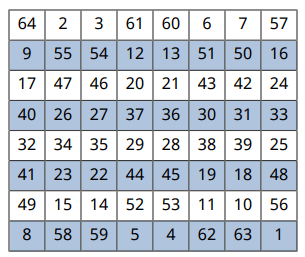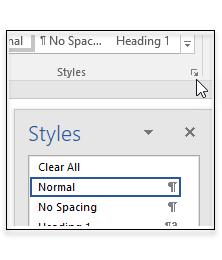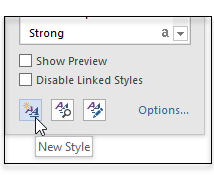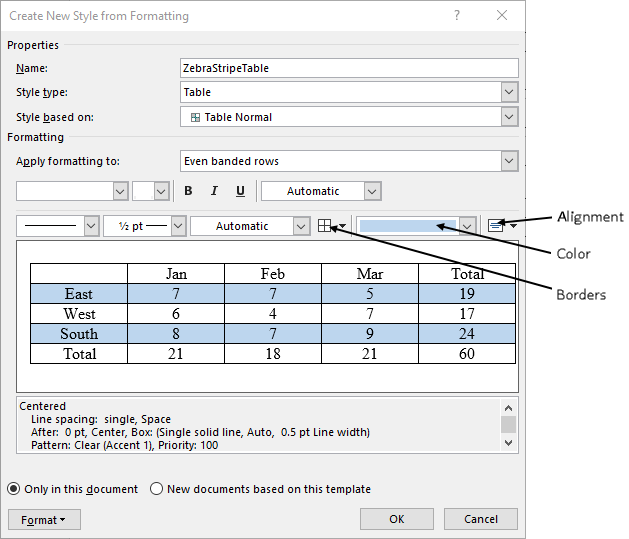Create a Zebra-Striped Table
This example shows how to create a table with alternating color rows or columns. These tables are called zebra-striped or banded tables. To create a zebra-striped table in a report, you can define it in a program or a template. The examples in this section have zebra-striped rows. Use a similar technique for zebra-striped columns.
The Report Generator APIs support creating zebra-striped tables programmatically or using a Word or HTML template. You cannot create a PDF report for a zebra-striped table using a PDF template.

Zebra-Striped Table Using a Program
This program creates an 8-by-8 magic square table. It has row background colors that alternate between blue and white, which can be helpful for reading and summing the rows. The program also includes formatting for the row height, table width, borders, and alignment of the cell entries.
import mlreportgen.report.* import mlreportgen.dom.* rpt = Report('zebraTable','pdf'); maglen = 8; mag = magic(maglen); tb = Table(mag); % Set the colors for alternating rows for i = 1:maglen r = tb.row(i); if mod(i,2)==0 r.Style = {BackgroundColor('lightsteelblue')}; else r.Style = {BackgroundColor('white')}; end end tb.Style={RowHeight('0.3in'),RowSep('solid'),ColSep('solid')}; tb.Width= '3in'; tb.TableEntriesVAlign = 'middle'; tb.TableEntriesHAlign = 'center'; tb.Border = 'single'; add(rpt,tb) close(rpt) rptview(rpt)
Zebra-Striped Table Using a Word Template
This example shows how to add a table style to a Word template that defines a zebra-striped table. Using a template modularizes your application. Instead of updating the program, which may introduce bugs, you can update the template.
1. Open a Word template. In this example, the template file is myrpt.dotx, which you can create using mlreportgen.report.Report.createTemplate('myrpt','docx'). To open a Word template file, right-click the file and then, click Open in the menu. (If you click the file directly, a .doc file that uses that template opens.)
2. Open the Styles pane as shown.

3. In the Styles pane, click the New Style button.

4. To define your table style, specify or select the field values. To match the programmatic zebra-striped table example, set these fields to apply the features to the table and table rows:
Name - Add
ZebraStripeTableas the name for the style. Use this style name to specify the style to use for the table in your program.Style Type -
TableApply formatting to -
Even banded rowsColor field
(No Color)- Select a color for the odd banded rows from the dropdown.
Then, set these fields to apply these additional features to the whole table:
Apply formatting to -
Whole tableAlignment -
Align CenterBorders -
All Borders

5. Click OK to save the new style.
6. Save the template file
7. In your program, specify the template file to use, and then, you can apply the new zebra-stripe style to a table in your program.
rpt = mlreportgen.dom.Document('myreport','docx','myrpt.dotx'); tb = Table(); tb.StyleName = 'ZebraStripeTable';
Not all formatting options that you can use in a program are available in Word. For this example to match the programmatic example, in addition to specifying styles in the Word template, you must specify the row height and table width in your program.
tb.Style = {RowHeight('0.3in')};
tb.Width = '3in';
This is the complete code for using the Word template, myrpt.dotx, to format a magic square as a zebra-striped table.
import mlreportgen.report.* import mlreportgen.dom.* rpt = mlreportgen.report.Report('myreport','docx','myrpt.dotx'); maglen = 8; mag = magic(maglen); tb = Table(mag); tb.StyleName = 'ZebraStripeTable'; tb.Style={RowHeight('0.3in')}; tb.Width= '3in'; add(rpt,tb) close(rpt); rptview(rpt)
Zebra-Striped Table Using an HTML Template
This example shows how to add a table style to an HTML template that defines a zebra-striped table. Using a template modularizes your application. Instead of updating the program, which may introduce bugs, you can update the template.
1. If you do not have an existing HTML template, create one using mlreportgen.report.Report.createTemplate('myrpt','html'). In this example, the template file is in a zipped template package, myrpt.htmtx.
2. Use unzipTemplate('myrpt.htmtx') to unzip the template to create a folder named myrpt, which contains the style sheets and image template files.
3. Go to the stylesheets folder in the myrpt folder. Open the root.css file in a text editor.
4. Create a CSS rule that defines a style name ZebraStripeTable for an HTML table element. To define the CSS rule for the ZebraStripeTable style, add the following lines to the root.css file. The background colors, #B0C4DE and #FFFFFF, are light blue and white, respectively.
/* Settings for whole table */
table.ZebraStripeTable {
text-align: center;
border: 1px solid black;
border-collapse: collapse;
width: 5in;
height: 4in;
}
/* Settings for table body */
table.ZebraStripeTable td {
padding: 0pt 0pt 0pt 0pt;
vertical-align: middle;
text-align: center;
border: 1px solid black;
border-collapse: collapse;
}
/* Zebra rows and colors */
tr:nth-child(even) {
background-color: #B0C4DE
}
tr:nth-child(odd) {
background-color: #FFFFFF
}5. Save the root.css file.
6. Use zipTemplate('myrpt') to zip the template files back to the myrpt.htmtx template package.
7. In your program, specify ZebraStripedTable as the style of your table.
rpt = mlreportgen.report.Report('myreport','html','myrpt.htmtx'); tb = Table(); tb.StyleName = 'ZebraStripeTable';
This is the complete code for using the HTML template, myrpt.htmtx, to format a magic square as a zebra-striped table.
import mlreportgen.report.* import mlreportgen.dom.* rpt = mlreportgen.report.Report('myreport','html','myrpt.htmtx'); maglen = 8; mag = magic(maglen); tb = Table(mag); tb.StyleName = 'ZebraStripeTable'; add(rpt,tb); close(rpt); rptview(rpt);